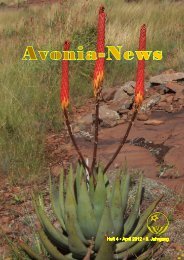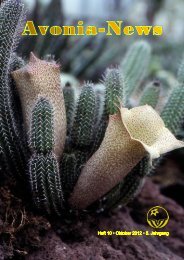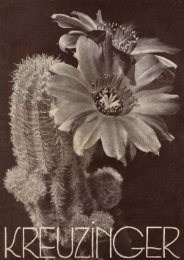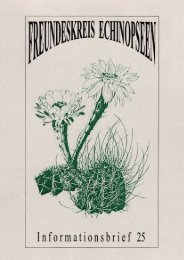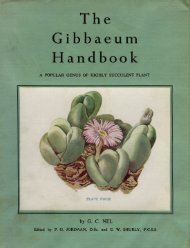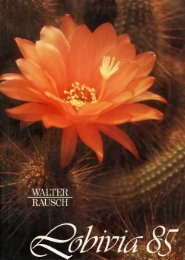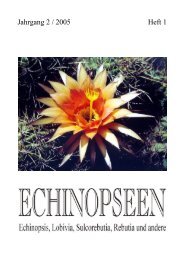VOLUME 14 :: January—October, 1952 Illustrations shown in ...
VOLUME 14 :: January—October, 1952 Illustrations shown in ...
VOLUME 14 :: January—October, 1952 Illustrations shown in ...
You also want an ePaper? Increase the reach of your titles
YUMPU automatically turns print PDFs into web optimized ePapers that Google loves.
28 THE CACTUS AND SUCCULENT April, <strong>1952</strong><br />
CULTIVATION OF SUCCULENTS<br />
By W. DENTON, B. E. M.<br />
In the last issue of our Journal, <strong>in</strong> my succulent notes, I promised to discuss seed sow<strong>in</strong>g as I considered there<br />
was still time to obta<strong>in</strong> satisfactory small plants by those people who were not <strong>in</strong> the position to give the heat<br />
necessary for a start <strong>in</strong> February. In look<strong>in</strong>g up my remarks last October, 1 note that I dealt with this subject<br />
rather fully, and so I do not wish to weary you with undue repetition. I am afraid there is very little I can add to<br />
the general pr<strong>in</strong>ciple then laid down. In talk<strong>in</strong>g about <strong>in</strong>dividual plants I shall endeavour to expla<strong>in</strong> how I slightly<br />
alter the pott<strong>in</strong>g compost to suit particular specimens and genera.<br />
John Innes general mixture is what I use and this is added to, and sifted, to suit the various families I am deal<strong>in</strong>g<br />
with. Any late sown Lithops from last year could now be pricked out <strong>in</strong> new conta<strong>in</strong>ers. It is not possible to take<br />
out the seedl<strong>in</strong>gs as <strong>in</strong>dividuals, the best way is to turn out the lot, mak<strong>in</strong>g sure that the compost is neither too<br />
wet, nor dry, but just at the right consistency for you to separate them without damage to the t<strong>in</strong>y tap roots. This<br />
is not as easy as it sounds, and does require great care. One other po<strong>in</strong>t I have noted with these, it is a very tedious<br />
job prick<strong>in</strong>g out these seedl<strong>in</strong>gs and the tendency is to take out the largest and not trouble about the very small<br />
ones. This year take the trouble to save a few of these very small chaps ; <strong>in</strong> lots of cases they turn out to be of<br />
the most pretty mark<strong>in</strong>gs and it does make a difference to the general collection when viewed as a whole.<br />
Anyone who has seen a pan of thirty or forty seedl<strong>in</strong>gs, say of Lithops fulleri or fossulifera will know what I<br />
mean, some are much nicer than others <strong>in</strong> the mark<strong>in</strong>gs. The genus Titanopsis is one that I have been <strong>in</strong>terested<br />
<strong>in</strong> for many years and I note it is a very popular plant with members, so a few words about them may be useful.<br />
I often wish that my grow<strong>in</strong>g conditions were better, surrounded as I am with smoky chimneys and closed-<strong>in</strong><br />
conditions <strong>in</strong> the heart of London, I labour with a great disadvantage as this is a plant that very def<strong>in</strong>itely requires<br />
clean air and bright conditions.<br />
There are the follow<strong>in</strong>g species : T. calcarea, setifera, fulleri, schwantesii, primosii, luckhoffii, triebneri (hugoschlechteri<br />
syn. astridea) and one I had sent me years ago called renoforme that I have not s<strong>in</strong>ce heard of. They will<br />
stand colder conditions than most plants and certa<strong>in</strong>ly require an additional amount of lime <strong>in</strong> the compost. I have<br />
exam<strong>in</strong>ed many of these, <strong>in</strong> pre-war years, collected from their native habitats and imported here and have noted<br />
that the soil attached is very loamy and sandy and powders up f<strong>in</strong>e when compressed. Therefore, I consider that<br />
mortar rubble from an old wall very suitable to add to our base compost. The sand used by builders for this purpose<br />
is pit sand and that is not nearly so sharp as we normally use. Three parts John Innes and one part rubble, as above,<br />
should be suitable. Ample dra<strong>in</strong>age of lime stone chips should be provided and, when pott<strong>in</strong>g, sit the plant on<br />
a base of sharp sand. They are summer growers and water<strong>in</strong>g should be commenced about April and carried<br />
on with until after flower<strong>in</strong>g when they naturally go to rest. Dry all the w<strong>in</strong>ter please for these. The most<br />
popular one is calcarea, this is by far the easiest one to cultivate and makes a very pretty specimen, especially when<br />
you have the true variety and not one of the hybrids so frequently met with. The others are not so easy. They<br />
all grow well from seed and make nice plants <strong>in</strong> one year. I have had them <strong>in</strong> flower the first year and they nearly<br />
always bloom <strong>in</strong> the second year. It is the w<strong>in</strong>ter that beats you with these.<br />
T. hugo-schlechteri is one of the most difficult plants I have ever tried to grow and I have, up to now, never<br />
kept one longer than three years. Last year I tried a new method, I potted this <strong>in</strong> a very deep pot, seven <strong>in</strong>ches by<br />
three <strong>in</strong>ches, <strong>in</strong> the above-mentioned compost and grew plunged <strong>in</strong> a tray. I kept this <strong>in</strong> partial shade the whole<br />
of last summer and I now have this plant look<strong>in</strong>g f<strong>in</strong>e and enter<strong>in</strong>g its fourth year. Perhaps, and I say this with<br />
reserve, it may grow under the shade of tall grass or shrubs <strong>in</strong> its native home. I do not know, but such is my<br />
experience with this. I should be glad to know how other people f<strong>in</strong>d this plant and expect to be found fault with.<br />
I still have plenty to learn about all my members of the succulent families and would welcome any criticism as to<br />
my methods of culture.<br />
Special care should be taken with all Titanopsis plants, <strong>in</strong> water<strong>in</strong>g never allow any to settle between the leaves,<br />
they rot off very quickly.<br />
Conophyttims should, about now, beg<strong>in</strong> to change colour and you will notice they take on a purple hue at the<br />
base, this is a sign they are go<strong>in</strong>g to rest and that the new growths are on the way and be<strong>in</strong>g nourished by the sap<br />
of the old ones. Gradually dry off and keep dry for the next few months. About mid-July onwards they will<br />
burst open the old leaves, then you can give a little water. Do not be <strong>in</strong> a hurry to start water<strong>in</strong>g the Lithops,




